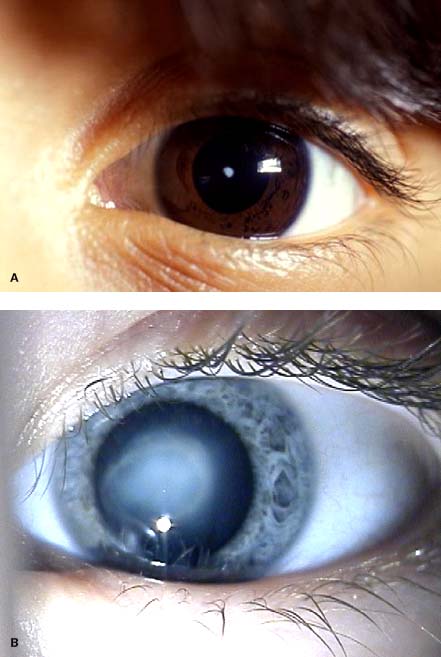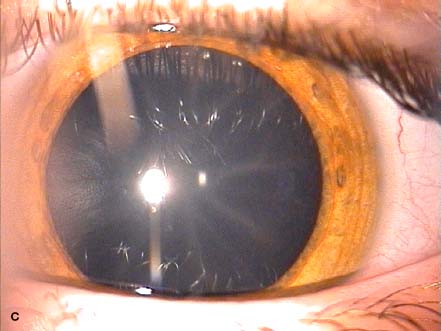5
Lens Anomalies
CONGENITAL AND DEVELOPMENTAL CATARACTS
Jonathan H. Salvin and Hillary Gordon 
Cataracts are an opacification of the lens of the eye, typically associated with age. Congenital cataracts may present at or soon after birth, whereas developmental cataracts present during childhood. They may be unilateral or bilateral and may result in decreased visual acuity or blindness from the opacification and subsequent amblyopia (Fig. 5-1).
Etiology
 The prevalence is 1 to 15 per 10,000 children.
The prevalence is 1 to 15 per 10,000 children.
 Idiopathic (60% bilateral cases, 80% unilateral cases)
Idiopathic (60% bilateral cases, 80% unilateral cases)
 Familial (30% cases)
Familial (30% cases)
 Genetic and metabolic diseases associated with cataract
Genetic and metabolic diseases associated with cataract
 Galactosemia
Galactosemia
 Alport’s syndrome
Alport’s syndrome
 Fabry’s disease
Fabry’s disease
 Myotonic dystrophy
Myotonic dystrophy
 Diabetes mellitus
Diabetes mellitus
 Trisomy 21
Trisomy 21
 Trisomy 18
Trisomy 18
 Trisomy 13
Trisomy 13
 Systemic illnesses associated with cataract include:
Systemic illnesses associated with cataract include:
 Juvenile idiopathic arthritis
Juvenile idiopathic arthritis
 Systemic lupus erythematosus
Systemic lupus erythematosus
 Malignancies
Malignancies
 Ocular abnormalities associated with cataract include:
Ocular abnormalities associated with cataract include:
 Aniridia
Aniridia
 Persistent hyperplastic primary vitreous (PHPV)
Persistent hyperplastic primary vitreous (PHPV)
 Anterior segment dysgenesis
Anterior segment dysgenesis
 Maternal infection associated with cataract include:
Maternal infection associated with cataract include:
 Rubella
Rubella
 Cytomegalovirus
Cytomegalovirus
 Varicella
Varicella
 Herpes simplex virus
Herpes simplex virus
 Toxoplasmosis
Toxoplasmosis
 Syphilis
Syphilis
Signs and Symptoms
 Variable lens opacity from small white spots in pupils to complete leukocoria
Variable lens opacity from small white spots in pupils to complete leukocoria
 Decreased visual acuity
Decreased visual acuity
 Asymmetric, diminished, or absent red reflex
Asymmetric, diminished, or absent red reflex
 Nystagmus
Nystagmus
 Photophobia
Photophobia
 Failure to meet developmental milestones
Failure to meet developmental milestones
 Poor visual development in infants
Poor visual development in infants
Diagnostic Evaluation
 Detailed history with specific attention to family history, trauma, systemic steroid use, radiation exposure, maternal infection, systemic illness in child, and visual developmental milestones or visual changes
Detailed history with specific attention to family history, trauma, systemic steroid use, radiation exposure, maternal infection, systemic illness in child, and visual developmental milestones or visual changes
 Physical examination includes complete ophthalmologic examination with pupillary dilation, retinoscopy, slit-lamp examination, and visual acuity testing and indirect ophthalmoscopy
Physical examination includes complete ophthalmologic examination with pupillary dilation, retinoscopy, slit-lamp examination, and visual acuity testing and indirect ophthalmoscopy
 B-scan ultrasonography
B-scan ultrasonography
 Infants may require general anesthesia for full examination.
Infants may require general anesthesia for full examination.
 Full physical examination with attention paid to growth and developmental milestones and appropriate referral for genetic, infectious, and metabolic testing
Full physical examination with attention paid to growth and developmental milestones and appropriate referral for genetic, infectious, and metabolic testing
Treatment
 Cataract >3 mm, dense nuclear cataract, and cataract preventing full refraction or associated with nystagmus or strabismus are indications for surgery with or without intraocular lens replacement.
Cataract >3 mm, dense nuclear cataract, and cataract preventing full refraction or associated with nystagmus or strabismus are indications for surgery with or without intraocular lens replacement.
 In children younger than 7 years of age, treatment should be initiated within weeks after diagnosis to avoid the development of amblyopia.
In children younger than 7 years of age, treatment should be initiated within weeks after diagnosis to avoid the development of amblyopia.
 Partial cataracts may require surgery or may be managed medically depending on the extent of the cataract and the surgical risks. If visual acuity can accurately be measured to better than 20/50, pupillary dilation can be attempted for management. If the visual acuity cannot be accurately measured or is measure to be 20/50 or worse, surgery should be considered.
Partial cataracts may require surgery or may be managed medically depending on the extent of the cataract and the surgical risks. If visual acuity can accurately be measured to better than 20/50, pupillary dilation can be attempted for management. If the visual acuity cannot be accurately measured or is measure to be 20/50 or worse, surgery should be considered.
 Postoperative aphakic refractive correction (glasses or contact lenses) immediately after surgery
Postoperative aphakic refractive correction (glasses or contact lenses) immediately after surgery
 Amblyopia treatment after cataract extraction
Amblyopia treatment after cataract extraction
 Appropriate referral of patient for evaluation and treatment of any underlying disease
Appropriate referral of patient for evaluation and treatment of any underlying disease
Prognosis
 Depends on the age at development diagnosis, treatment of the cataract, the type of cataract, the laterality, and surgical complications
Depends on the age at development diagnosis, treatment of the cataract, the type of cataract, the laterality, and surgical complications
 In young children, postoperative prognosis depends on adherence to amblyopia treatment.
In young children, postoperative prognosis depends on adherence to amblyopia treatment.
REFERENCES
Amaya L, Taylor D, Russell-Eggitt I, et al. The morphology and natural history of childhood cataracts. Surv Ophthalmol. 2003;48:125–144.
Lim Z, Rubab S, Chan YH, et al. Pediatric cataract: the Toronto experience-etiology. Am J Ophthalmol. 2010; 149(6):887–892.
Lin AA, Buckley EG. Update on pediatric cataract surgery and intraocular lens implantation. Curr Opin Ophthalmol. 2010;21(1):55–59.
FIGURE 5-1. A. Anterior polar cataract: central anterior lens opacity generally less than 1 mm in diameter. These are rarely visually significant. B. Congenital nuclear cataract: large central nuclear opacity. This cataract is visually significant and requires surgical removal. C. Stellate congenital cataract: stellate, spokelike cortical lens opacity. Initially, this may not be visually significant, but it may progress to a total opacity.


Stay updated, free articles. Join our Telegram channel

Full access? Get Clinical Tree


